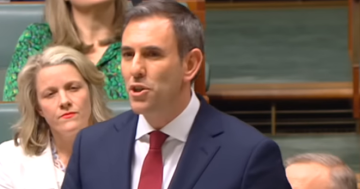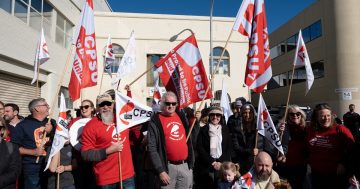Michael Janda and Rhiana Whitson* say wages have made the biggest jump in over a decade, but public servants aren’t reaping the benefits.
 The official measure of wages growth is finally starting to take off, but public sector workers like Kimbra Pettit are being left further behind.
The official measure of wages growth is finally starting to take off, but public sector workers like Kimbra Pettit are being left further behind.
The official wage price index jumped 1 per cent over the September quarter, the fastest rate of increase since March 2012, and was up 3.1 per cent over the year to September.
But Ms Pettit has not yet seen any of those gains.
She is a hospital cleaner employed by the state government in Tasmania, where annual inflation is the highest in the country at 8.6 per cent.
Inflation averaged 7.3 per cent across the country in the September quarter.
Thousands of the state’s public sector workers are in a pay dispute with the state government and went on strike in protest against a pay offer that works out to be 3 per cent a year.
“We’re in a no-win situation at the moment,” Ms Pettit said.
“They’re [the state government] giving us this paltry amount of money, and the costs are just going further and further up.”
Ms Pettit said staff were using sick leave instead of spending on petrol and car parking.
“We start early in the morning before buses and anything else, so we haven’t got the luxury of using public transport to cheapen our load.”
Private sector dominates gains, retail workers get award boost
Private sector wages drove the increase, up 1.2 per cent over the quarter, while public sector employees saw quarterly pay increases that were just half that, according to data from the Australian Bureau of Statistics (ABS).
Over the past year, private sector employees have seen an average wage increase of 3.4 per cent, while public sector workers have seen their base pay rise by 2.4 per cent.
“Labour market pressures in the private sector combined with the largest Fair Work Commission award increase in more than a decade saw rises in both the size of average wage changes and the proportion of private sector jobs recording a wage change,” said the ABS’s program manager of prices, Michelle Marquardt.
In the private sector, 46 per cent of employees received a wage rise over the three months to September 30, and the average pay bump for those who did was 4.3 per cent.
The Fair Work Commission increased the minimum wage by 5.2 per cent in a decision that took effect from July 1, while wages for workers covered by awards generally rose by 4.6 per cent.
Retail workers were particular beneficiaries of this increase, with a large proportion on award wages.
Workers in that sector had the largest quarterly pay increase of any industry (2.4 per cent) and the largest annual increase (4.2 per cent), although the annual rise was partly a catch-up after part of the previous year’s award increase for that industry was delayed until this year.
Individual agreements, moving jobs drive wage rise
Despite this boost, the biggest contributor to wage growth across the economy was an increase for workers on individual agreements, while pay rises from enterprise agreements also added to wage pressures.
Matt Cowgill, chief economist at jobs website Seek, said the official wage price index is starting to catch up to the kind of advertised salary increases he had observed over the past year.
“We saw advertised salaries really take off through the second half of 2021 as we emerged from COVID lockdowns and then through the first half of 2022,” he told ABC News Channel.
“Over the year to September, advertised salaries were up by 3.7 per cent.
“So running a bit hotter even than these relatively quick wage price index numbers.”
The lowest pay increases were seen in the education and training sector, at 0.8 per cent for the quarter and 2.2 per cent for the year.
Teachers across several jurisdictions and academics at many universities are currently engaged in industrial action to seek larger pay increases.
Mr Cowgill said leaving your current employer was a key way to get a bigger pay rise, but this was difficult or impossible for people who worked in industries where the government was the main, or even sole, employer.
“The best way to get a pay rise is to get a new job,” he said.
“It certainly is reflected in our data as well, with advertised salaries rising a bit faster than wages and salaries for all employees.”
*Michael Janda has been the ABC’s Online Business Reporter since 2009. Rhiana Whitson is a reporter with the ABC’s national business unit in Melbourne.
This article first appeared at abc.net.au.









